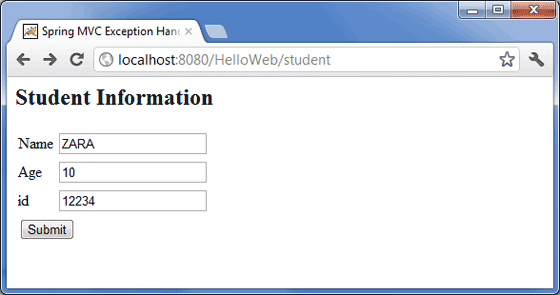Spring exception handling example
May 14, 2021 Spring
Table of contents
Spring exception handling example
The following example shows how to use the Spring MVC framework to write a simple web-based application that can handle one or more exceptions generated by its built-in controller. To get started with it, let's use the Eclipse IDE in the right place, and then follow the steps below to develop a dynamic form-based web application using Spring's web framework:
| Steps | Describe |
|---|---|
| 1 | Create a dynamic Web project named HelloWeb, and create a package com.tutorialspoint in the src folder of the project you have created. |
| 2 | Drag the Spring and other libraries mentioned above into the folder WebContent/WEB-INF/lib. |
| 3 | Create a Java-class Student, StudentController, and SpringException under the com.tutorialspoint package. |
| 4 | Create Spring's Profile Web Portal and HelloWeb-servlet .xml the WebContent/WEB-INF .xml. |
| 5 | Create a subf folder with the name jsp under the WebContent/WEB-INF folder. Create a view file student, result, .jsp, error.jsp.jsp and ExceptionPage .jsp under this sub.jsp. |
| 6 | The final step is to create all the source code and profile content and export the application, as explained below. |
Here's .java the Student file:
package com.tutorialspoint;
public class Student {
private Integer age;
private String name;
private Integer id;
public void setAge(Integer age) {
this.age = age;
}
public Integer getAge() {
return age;
}
public void setName(String name) {
this.name = name;
}
public String getName() {
return name;
}
public void setId(Integer id) {
this.id = id;
}
public Integer getId() {
return id;
}
}Here's what SpringException .java the contents of the file:
package com.tutorialspoint;
public class SpringException extends RuntimeException{
private String exceptionMsg;
public SpringException(String exceptionMsg) {
this.exceptionMsg = exceptionMsg;
}
public String getExceptionMsg(){
return this.exceptionMsg;
}
public void setExceptionMsg(String exceptionMsg) {
this.exceptionMsg = exceptionMsg;
}
}Here's what studentController .java the file. H ere, you need to @ExceptionHandler to annotate a service method, and you can specify one or more exceptions to handle. If you want to specify more than one exception, you can use commas to separate these values.
package com.tutorialspoint;
import org.springframework.stereotype.Controller;
import org.springframework.web.bind.annotation.ExceptionHandler;
import org.springframework.web.bind.annotation.ModelAttribute;
import org.springframework.web.bind.annotation.RequestMapping;
import org.springframework.web.bind.annotation.RequestMethod;
import org.springframework.web.servlet.ModelAndView;
import org.springframework.ui.ModelMap;
@Controller
public class StudentController {
@RequestMapping(value = "/student", method = RequestMethod.GET)
public ModelAndView student() {
return new ModelAndView("student", "command", new Student());
}
@RequestMapping(value = "/addStudent", method = RequestMethod.POST)
@ExceptionHandler({SpringException.class})
public String addStudent( @ModelAttribute("HelloWeb")Student student,
ModelMap model) {
if(student.getName().length() < 5 ){
throw new SpringException("Given name is too short");
}else{
model.addAttribute("name", student.getName());
}
if( student.getAge() < 10 ){
throw new SpringException("Given age is too low");
}else{
model.addAttribute("age", student.getAge());
}
model.addAttribute("id", student.getId());
return "result";
}
}The following is the spring web profile web .xml content
<web-app id="WebApp_ID" version="2.4"
xmlns="http://java.sun.com/xml/ns/j2ee"
xmlns:xsi="http://www.w3.org/2001/XMLSchema-instance"
xsi:schemaLocation="http://java.sun.com/xml/ns/j2ee
http://java.sun.com/xml/ns/j2ee/web-app_2_4.xsd">
<display-name>Spring Exception Handling</display-name>
<servlet>
<servlet-name>HelloWeb</servlet-name>
<servlet-class>
org.springframework.web.servlet.DispatcherServlet
</servlet-class>
<load-on-startup>1</load-on-startup>
</servlet>
<servlet-mapping>
<servlet-name>HelloWeb</servlet-name>
<url-pattern>/</url-pattern>
</servlet-mapping>
</web-app>
Here's another Spring web profile, HelloWeb-servlet.xml content
<beans xmlns="http://www.springframework.org/schema/beans"
xmlns:context="http://www.springframework.org/schema/context"
xmlns:xsi="http://www.w3.org/2001/XMLSchema-instance"
xsi:schemaLocation="
http://www.springframework.org/schema/beans
http://www.springframework.org/schema/beans/spring-beans-3.0.xsd
http://www.springframework.org/schema/context
http://www.springframework.org/schema/context/spring-context-3.0.xsd">
<context:component-scan base-package="com.tutorialspoint" />
<bean class="org.springframework.web.servlet.view.InternalResourceViewResolver">
<property name="prefix" value="/WEB-INF/jsp/" />
<property name="suffix" value=".jsp" />
</bean>
<bean class="org.springframework.web.servlet.handler.
SimpleMappingExceptionResolver">
<property name="exceptionMappings">
<props>
<prop key="com.tutorialspoint.SpringException">
ExceptionPage
</prop>
</props>
</property>
<property name="defaultErrorView" value="error"/>
</bean>
</beans>
Here, you specify ExceptionPage as an exception view so that SpringException occurs, and if any other type of exception occurs, a generic view error occurs.
Here's what spring .jsp student does:
<%@taglib uri="http://www.springframework.org/tags/form" prefix="form"%>
<html>
<head>
<title>Spring MVC Exception Handling</title>
</head>
<body>
<h2>Student Information</h2>
<form:form method="POST" action="/HelloWeb/addStudent">
<table>
<tr>
<td><form:label path="name">Name</form:label></td>
<td><form:input path="name" /></td>
</tr>
<tr>
<td><form:label path="age">Age</form:label></td>
<td><form:input path="age" /></td>
</tr>
<tr>
<td><form:label path="id">id</form:label></td>
<td><form:input path="id" /></td>
</tr>
<tr>
<td colspan="2">
<input type="submit" value="Submit"/>
</td>
</tr>
</table>
</form:form>
</body>
</html>
Here's what spring view .jsp is all about:
<html>
<head>
<title>Spring Error Page</title>
</head>
<body>
<p>An error occured, please contact webmaster.</p>
</body>
</html>;
The following is the Spring view file ExceptionPage .jsp content. Here, you'll access the exception instance with $.exception.
<%@taglib uri="http://www.springframework.org/tags/form" prefix="form"%>
<html>
<head>
<title>Spring MVC Exception Handling</title>
</head>
<body>
<h2>Spring MVC Exception Handling</h2>
<h3>${exception.exceptionMsg}</h3>
</body>
</html>
Here's what the Spring view .jsp content is:
<%@taglib uri="http://www.springframework.org/tags/form" prefix="form"%>
<html>
<head>
<title>Spring MVC Form Handling</title>
</head>
<body>
<h2>Submitted Student Information</h2>
<table>
<tr>
<td>Name</td>
<td>${name}</td>
</tr>
<tr>
<td>Age</td>
<td>${age}</td>
</tr>
<tr>
<td>ID</td>
<td>${id}</td>
</tr>
</table>
</body>
</html>
Finally, here's a list of Spring and other libraries included in your web application. You just need to drag these files into the WebContent/WEB-INF/lib folder.
-
commons-logging-x.y.z.jar
-
org.springframework.asm-x.y.z.jar
-
org.springframework.beans-x.y.z.jar
-
org.springframework.context-x.y.z.jar
-
org.springframework.core-x.y.z.jar
-
org.springframework.expression-x.y.z.jar
-
org.springframework.web.servlet-x.y.z.jar
-
org.springframework.web-x.y.z.jar
- spring-web.jar
Once you're done creating source code and profiles, export your application. Right-click on your application, use the Export and WAR File option, and save your HelloWeb.war file in Tomcat's webapps folder.
Now start your Tomcat server and make sure you can access other web pages in the webapps folder using a standard browser. N ow try to access the URL http://localhost:8080/SpringWeb/student. If your Spring web application is all right, you should see the following results:

Enter the value shown in the figure above, and then click the submit button. If your Spring web application is all right, you should see the following results:
